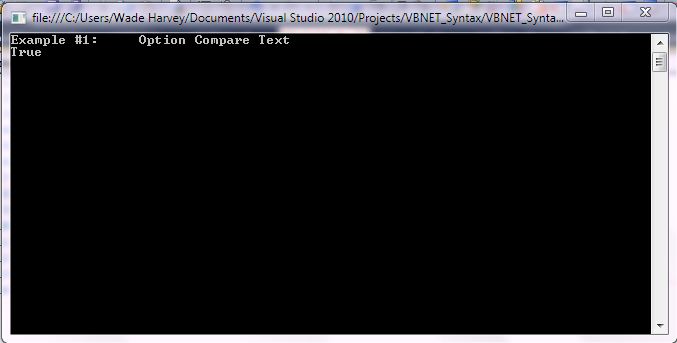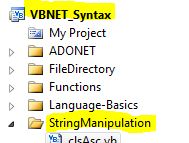VB.NET OptionCompare() – Code Sample Syntax Example
Posted by asp.net videos on Sunday, February 20, 2011 · Leave a Comment
Premium (Not Free) Video Tutorials
Free Video Tutorials & Free Tools
Premium (Not Free) Video Tutorials
Free Video Tutorials & Free Tools
VB.NET OptionCompare Example – Code Sample Syntax
Abstract: – Illustrates using VB.NET OptionCompare Code Example.
*** 2. OptionCompare Syntax ***
Purpose:
Declares the default comparison method to use when comparing string data.
Syntax:
Option Compare { Binary | Text }
| Parameters |
Description |
Binary/Text |
Binary – Optional – compares based on binary representation – case sensitive
Text – Optional – compares based on text representation – case insensitive
|
| Result Data Type |
Description |
comparisons |
case sensitive if binary is specified; case insensitive if
text is specified. NOTE: Option statement must appear in a file before
any other source code statements
|
*** 3. OptionCompare – Quick Example ***
|
Console.WriteLine(“A” = “a”) ‘ Returns True when Option Compare Text is specified at top of page
|
*** 4. OptionCompare – Full Example ***
OptionCompare Example Output Screenshot

Step 1: Click Visual Basic to Cut-n-paste code into clsOptionCompare.vb
Option Compare Text
Public Class clsOptionCompare
Public Sub Main()
'****************************************************************************************
' Purpose: Declares the default comparison method to use when comparing string data.
'
' Syntax: Option Compare { Binary | Text }
'
' Parameter1: Binary/Text - Binary - Optional - compares based on binary representation - case sensitive
' Text - Optional - compares based on text representation - case insensitive
'
' Result: comparisons - case sensitive if binary is specified; case insensitive if
' text is specified. NOTE: Option statement must appear in a file before
' any other source code statements
'
' Quick Example:
' Console.WriteLine("A" = "a") ' Returns True when Option Compare Text is specified at top of page
'
'****************************************************************************************
Console.WriteLine("Example #1: Option Compare Text")
Console.WriteLine("A" = "a") ' Returns True
'write blank line to make output easier to read
Console.WriteLine()
'Prevent console from closing before you press enter
Console.ReadLine()
End Sub
End Class |
Option Compare Text
Public Class clsOptionCompare
Public Sub Main()
'****************************************************************************************
' Purpose: Declares the default comparison method to use when comparing string data.
'
' Syntax: Option Compare { Binary | Text }
'
' Parameter1: Binary/Text - Binary - Optional - compares based on binary representation - case sensitive
' Text - Optional - compares based on text representation - case insensitive
'
' Result: comparisons - case sensitive if binary is specified; case insensitive if
' text is specified. NOTE: Option statement must appear in a file before
' any other source code statements
'
' Quick Example:
' Console.WriteLine("A" = "a") ' Returns True when Option Compare Text is specified at top of page
'
'****************************************************************************************
Console.WriteLine("Example #1: Option Compare Text")
Console.WriteLine("A" = "a") ' Returns True
'write blank line to make output easier to read
Console.WriteLine()
'Prevent console from closing before you press enter
Console.ReadLine()
End Sub
End Class Step 2: Click Visual Basic to Cut-n-paste code into Module1.vb
Module Module1
Sub Main()
Dim myclsOptionCompare As New clsOptionCompare
myclsOptionCompare.Main()
End Sub
End Module |
Module Module1
Sub Main()
Dim myclsOptionCompare As New clsOptionCompare
myclsOptionCompare.Main()
End Sub
End Module Prerequistes:
- Install Visual Basic (Express or Standard Edition)
- Install SQL Server Express
- Download Northwind and pubs Database
- Attach Northwind Database to Databases in Sql Express
- Attach pubs Database to Databases in Sql Express
Notes:
- Console Application is used to simplify things, but Windows Forms or Web Forms could also be used
- You can build a library of syntax examples by using same project over and over and just commenting out what you do not want to execute in Module1.vb
Instructions:

- Use Visual Basic 2010 Express or Standard Edition
- Create new project;
- Click File/New Project
- Select Console Application Template
- Select Visual Basic for Language
- name of project could be VBNET_Syntax.
- Add New folder named “StringManipulation”
- Right-click project name in solution explorer;
- add new folder;
- name of folder could be: StringManipulation
- Add Class Named clsOptionCompare to StringManipulation folder
- Right-click StringManipulation folder;
- add new item;
- Select class
- Class name could be clsOptionCompare
- Click on Visual Basic in code in step 1 above to copy code into clsOptionCompare.vb
- Click on Visual Basic in code in step 2 above to copy code into Module1.vb
- Click green arrow or press F5 to run program
|
 Download Source Code for All VB Console Examples in One Project
Download Source Code for All VB Console Examples in One Project
